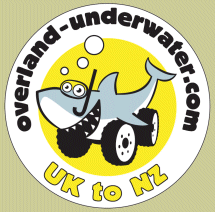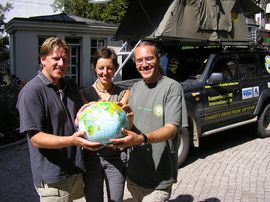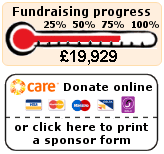| Final Statistics: Alex & Maz | Total distance: 93,550km |
| Furthest Point: Rotorua, NZ | Now settled in Sydney, Australia |
| Final Statistics: Martin | Total distance: 79,698km |
| Furthest Point: Hobart, Australia | Now settled in Bristol, UK |
That's one weedy dragon....
Australia, Country 26, Diary entry 17th - 24th Jan 2007, Total distance in Australia: Unknown, Distance to date: 18,320KM
After leaving Albany, we spent the next few hours on the road to Bremmer Bay. While talking in the dive shop with Gary, we'd mentioned that we once used to live in Adelaide. He asked us if we'd seen the leafy sea dragon while diving there, but we had to admit that after much hunting we'd never managed to find one. He had a friend in Bremmer Bay who dived with the sea dragons all year round and was sure that he'd had sightings recently.
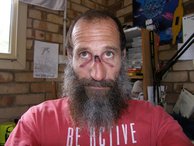 Having ummed and arhed for a while as whether to pop in - diving in Australia is very expensive and more than twice the cost of a normal boat dive in the UK - we decided that maybe we should just do one on the off chance. We Justified the cost by saying we'd kick ourselves for missing the chance later. So, early evening we found ourselves talking with Gary from Lebens Diving Services in Bremmer Bay, organising the next days activity. Gary was sporting a rather nasty gash on the bridge of his nose with 10 stitches holding it together and the blossoming of two black eyes were just beginning to show. He'd just had a commercial diving accident, so was keen to get back in the water the next day to see if he could actually dive without his mask giving him too much pain. After trying on some super sexy 70's style 5mm wetsuits and reconfiguring all our kit back to diving with one cylinder, we arranged to meet the next day at 8am and headed off to find camp.
Having ummed and arhed for a while as whether to pop in - diving in Australia is very expensive and more than twice the cost of a normal boat dive in the UK - we decided that maybe we should just do one on the off chance. We Justified the cost by saying we'd kick ourselves for missing the chance later. So, early evening we found ourselves talking with Gary from Lebens Diving Services in Bremmer Bay, organising the next days activity. Gary was sporting a rather nasty gash on the bridge of his nose with 10 stitches holding it together and the blossoming of two black eyes were just beginning to show. He'd just had a commercial diving accident, so was keen to get back in the water the next day to see if he could actually dive without his mask giving him too much pain. After trying on some super sexy 70's style 5mm wetsuits and reconfiguring all our kit back to diving with one cylinder, we arranged to meet the next day at 8am and headed off to find camp.
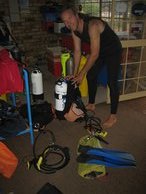
We popped down to little boat harbour where Gary had said we'd probably be alright to camp, but it was still busy with fishermen hunting a bite, so we ventured down Point Henry at the end of the peninsula. We found camp on a sand track overlooking the cliffs. With a south-westerly wind prevailing we were pretty sheltered but the sea was still lashing out at some of the rocks sending spray into the air. The whole panoramic took me back to my wetsuit diver training days in Cornwall; cold, wet, trying to shelter from the wind to stay warm, that's how I felt tomorrow would be. But you never know, we might just see a sea dragon - you don't get them in Cornwall! The temperature was dropping rapidly and soon we had our socks, boots and beanies on. It was going to be a cold day tomorrow.
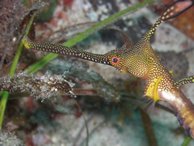
We woke early and just as we got out from the tent it began to rain. It was going to be a cold day today. We got to the shop in plenty of time and met up with the final member of the group who we'd be diving with today, Peter. Normally we'd beg and plead to be allowed to dive by ourselves, but today we'd stick next to Gary like bees round a honey pot. It was a lazy start, getting kit together on the back of the trailer and having the necessary cuppa to warm us up before venturing out to dive.
We kitted up on the beach, moaning how cold it was going to be. Gary was OK as he had a thick semi-dry suit on and Peter couldn't understand what our problem was....the water was going to be 20degrees, usually he'd dive in 23deg in just wetsuit long johns so today he donned his two piece, the same as we were wearing - we are after all POME wimps. In we strode to the waters edge and dipped beneath the waves.
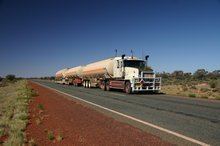
The first 25 minutes we spent frantically searching for the sea dragons camouflaging themselves in the weed which blew from side to side as the swell washed it around. The backward and forward motion made you feel quite seasick. As time carried on, I began thinking it was going to be an unlucky dive. Hunting around I spotted Gary making a beeline for something so followed his track. There it was, my first leafy sea dragon. Elegantly floating just above the weed, oblivious to 4 pairs of eyes ogling it, we followed it as it moved around. Alex began snapping like crazy in the hope he could get a good photo while Gary, Peter and I watched in fascination at this creature. Nearly 30cms in length, it had a rippled body and was accessorised with seaweed looking attachments along its back, abdomen and tail giving it the 'local environment look' to help it blend seamlessly into the background. They really are beautiful. For twenty minutes I was mesmerised by the dragon before Gary signalled he and Peter were going off to look for more.
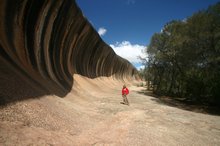
After 5 more minutes, Alex and I followed, just in time for Gary to show us a weedy sea dragon. These are less decorative in the camouflage armour they carry on themselves, but have a vibrant colour that the leafy's don't have. A mixture of oranges, yellows, blues and many more, these dragons are more aware of prying eyes and didn't hang around for long before twinkling and moving quickly into the shallows out of harms way. To make our dive even better, we then saw a second weedy hanging around before we turned to head back to the shore. An excellent dive and money well spent; in the excitement we didn't feel the cold once! All chatting simultaneously about what a great dive it had been we headed back to the shop.
Peter was staying with his family at the nearby caravan park, so sneaked us in so we could shower before carrying on our journey. After a brief introduction to the rest of the folks, we were invited to stay for lunch, at which we eagerly accepted. Soon we were wolfing down toasted sarnies with a lovely cup of tea. Dragon hunting is hungry work! Like with all our good plans, timings had gone a bit skew and we started on the road a little later than intended. It was now time to head inland and we drove until the sun was threatening to set before finding camp down a dirt track in a cluster of trees. Another night of great bush tucker washed down with one of our newly acquired Mad Fish wines. You can't beat this living sometimes.
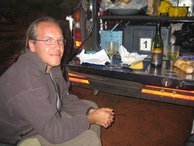
|
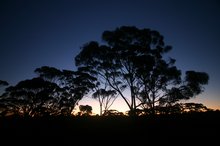
|
Our next destination was only a few kilometres away - Wave Rock. The name somewhat gives away the mystery of what we were about to see. The perfect 'surfers wave', 15m high and 100m long and frozen in solid rock marked with different colour bands. The bands of colour are caused by the run-off of waters containing carbonates and iron hydroxides. With water being a premium pretty much all round Australia, some remarkable fellows in the nearby town of Hyden decided to build a little wall on top of the wave to make it a water capture area - this unfortunately ruins to picturesque viewing of the wave unless you're right up against the rock and twist your next into an awkward position so the wall is out of view. A shame really. All being said, after 10 minutes of trying to get a picture without the wall in it, we could say we'd definitely 'done it' and ticked it off the list. Pretty spectacular but only worth the detour if you're in the area really.
We decided to take a dirt road towards Kalgoorlie and then follow part of the Holland Track. The Holland Track is a tribute to the extraordinary courage of four men and their achievement. In 1893 John Holland and his party cut 500 km of track from Broome Hill to Coolgardie in 2 months 4 days providing a short cut to the Goldfields from the port of Albany, a truly remarkable achievement. In the following 3 years an estimated 18,000 people used the "Holland Track" but its fame was short lived as the rail network was extended to Coolgardie providing much better transport and the use of the 'Holland Track' soon fizzled out.
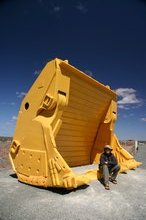
|
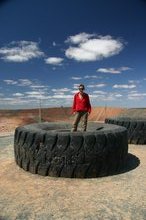
|
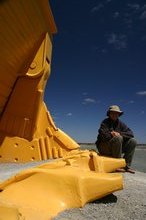
|
We began the track but with one wheel already broken, I was concerned that we were maybe pushing the car a little too far, especially as we knew we couldn't rely on the wheels anymore. I have to admit I wasn't in the mood either, so after about 50kms (and a rather animated 'debate') we rejoined the main road and carried on in relative safety to Kalgoorlie.
We reached Kalgoorlie by late afternoon, unfortunately too late for the shops to still be open so we found camp just outside town so we could begin our chores early the next day. A huge area of woodland was where we made base, on top of the red dirt we had seen so much of around Australia. We had a really lovely night. Cooked steak on an open fire and opened a bottle of red to enjoy. As the cheeses were keen to get out of the fridge and be tasted, we opened a bottle of white to enhance the flavour.
The next morning we arrived at the garage to be told that today was in fact Saturday. Of course, as with all major timings on this trip, deliveries don't happen on a weekend and the wheels hadn't arrived! Yet another fine conundrum we found ourselves in. Having travelled for 12,000km with 2 spares as 'we'd be mad without the back up', it was stupid for us to head off on a 1000km dirt track without replacing the wheel. We had to stay in Kalgoorlie for the weekend and hope the wheels turned up on Monday morning. The guy at the garage told us there was 'lots to do' in town, so after a cuppa we went to the information office to get more ideas.
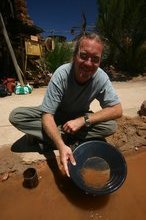
|
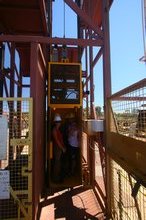
|
Kalgoorlie is the second-largest town in WA and the longest lasting and most successful of the gold mines in this state, so it has a lot going for it. A prosperous, humming metropolis in the middle of nowhere! It does have a feel of a US 'Wild West' frontier town, so we went exploring to see what we could find. History of the town is visible everywhere you go. In 1893 Paddy Hannan, a long time prospector of Irish descent (you'd never have guessed huh?) found enough gold lying on the surface to spark another rush. As with so many other places, the surface gold soon dried up, but at Kalgoorlie the miners went deeper continuing to discover payable gold 1500 feet below the surface. Later Boulder Mining leases came to be known as "The Golden Mile" and by all accounts this area contained the richest square mile of gold reserves in the world, leading the area onto a long boom period. After WWI Kalgoorlie began to slowly decline after increasing production costs and static gold prices and in 1934 bitter race riots erupted as mobs of Australian miners went on the rampage angrily setting fire to foreign owned businesses and shooting anyone deemed to be a foreigner. They were supposedly upset that preferences in shifts were being given to those of southern-European descent.
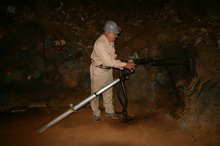
Over the years, mining techniques have changed and instead of the single operation, claustrophobic, long pitch-black shafts that were the main gateway to wealth, Kalgoorlie now has a 'super pit', an open cut mine which mine which has revolutionised mining. It was now possible to mine far more economically for gold and continue the harvest of the Golden Mile, which has produced nearly 50 million ounces of gold since the days of Hannan.
We went to have a look at this huge hole in the ground and check out what time the blast was, 1pm, so we headed back to town to have a wander before returning for the big bang. Congregations of people were now perched on the edge of the viewing platform waiting for the cloud of dust to erupt after the hole was blown. 1pm came and went and as people slowly began to fade, we realised the blast wasn't going to happen. The wind was blowing in the wrong direction so it couldn't go ahead, otherwise Kalgoorlie would get a fine coating of dust!
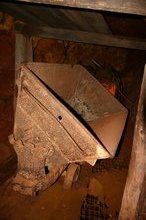
|
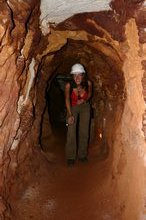
|
Most of the attractions are mining related in one way or another, so to fill our afternoon we headed to the Miners "Hall of Fame'. There's a lot of see here, and as we only arrived in the afternoon, our ticket was valid for 24hrs so we could come back the next morning as well. We started with a bit of gold panning in a pit where small specks of gold are thrown in for people to try and find. After a demonstration it was our turn. This involved getting an old tin can to scoop up the sand, soil and mud and water with potential for gold specks, then tip it out on to a flat bowl the size of a dinner plate and wash away all the sand and mud with water in a swirling motion, leaving any gold specks in the top of the bowl as they are much heavier. Miraculously, Alex found a speck on his first attempt and then promptly lost it again while trying to retrieve it as he didn't do it the way he was told! We carried on for another 15 minutes or so in the fun before the next tour was starting.
We continued on to the mineshaft, the real reason we'd visited the museum. We donned hard hats and descended 36m down into the ground. We had a tour from a gentleman who used to be a miner himself and looked at all the machines that were once in use before the super pit changed methodologies. They demonstrated some of the drills - they were so loud! It must have been a very hard life being down in the pits, with the noise, damp, heat and exhausting, labouring work. Made me quite look forward to hunting for an office job again!
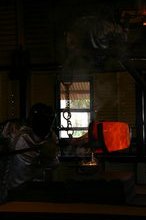
|
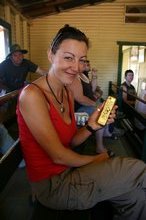
|
After the pit tour, it was time for a gold pouring demonstration. We all sat in the viewing area while the gold pot was extracted from the glowing golden crucible. A pretty simple procedure, but a dangerous one none the less. As the gold was cooling for us all to look at, we had a question and answer session. One of the questions was whether the sample was 100% pure gold. After telling us that you'd never be able to get 100% pure gold - there would always be a small amount of impurities in it - he began to explain about the costs and dangers involved if they did have gold bullion on site. Cameras, security guards etc.... were all raised as costs that the museum could not sustain, but there was also the safety of the tourists to consider.
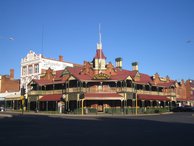
"Imagine if a 'nig nog' came in here with a gun......" the guide began to say. I didn't catch the rest of what he was saying, as Alex and I were both stunned into silence looking agog at each other, questioning if he had really said 'nig nog'!? Assuming he meant 'the black fella' as we've heard them called often enough, we couldn't believe our ears. One thing we have noticed over here, and also remembered from our last visit, was how 'un PC' the Aussies can be. There are no bars held when it comes to matters and opinions of different ethnic populations, which although are not always derogatory, the comments made here are not something you're ever likely to hear around the UK. Still, we enjoyed our time holding the bar of 'gold', along with real gold coins to get a feel for how heavy they were. 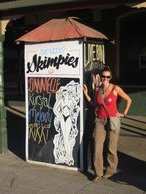
We returned to town and decided to go for a drink. Kalgoorlie has a number of pubs - at one stage there were 93 of them and the amount of alcohol consumed was twice the state average - so we had our pick. Alex was keen on one pub on the corner, nothing exceptional about the place itself I observed, until I looked beyond the pub door and saw the sign for 'skimpies'. A popular 'entertainment' in Kalgoorlie, skimpies are young ladies, dressed only in underwear, who serve behind the bar. An obvious enticement for business in a male dominated miner's town! Not surprisingly I was the only female. We just stayed for one, before retiring for the evening. 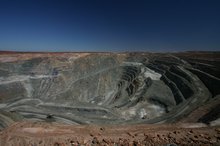 On the way home, we decided we'd give cooking a miss so stopped by Domino's for a 12 incher. It's somewhat different going 'home' to a patch of ground to pass away the evening rather than crash in front of the TV. We spent the evening chatting, chomping on pizza and sipping yet another delicious Mad Fish wine. We also had a call from Max wanting to catch up, it was good talking to him finding out what he'd been up to since leaving us in Malaysia.
On the way home, we decided we'd give cooking a miss so stopped by Domino's for a 12 incher. It's somewhat different going 'home' to a patch of ground to pass away the evening rather than crash in front of the TV. We spent the evening chatting, chomping on pizza and sipping yet another delicious Mad Fish wine. We also had a call from Max wanting to catch up, it was good talking to him finding out what he'd been up to since leaving us in Malaysia.
The next day we ventured to Boulder town, as it was market day, where they put on tours round the Super Pit. Market day happens once a month and amazingly we'd arrived at the right time. After a quick cuppa we jumped on the coach which was to take us round the open pit mine. The tour took about an hour, most of which we had to stay on the bus as we were given the history of the town, the goldfields, up to present day statistics.
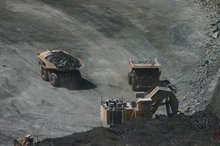
|
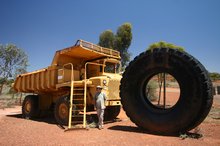
|
We passed the heaps of ore and rubble brought up from the pit, of which only 2 grams per tonne of ore is extracted. As you look out over the pit, you can see small holes, reminders of the previous tunnels dug before the Super Pit began. Over the years, 3500km of tunnels have been dug......as far as driving from Kalgoorlie to Melbourne! Now, the 500m deep pit was presented before us surrounded by winding roads for ginormous trucks used to carry rubble and ore. These are MONSTER trucks, making our Tinfish pale into obscurity. One of the shovel trucks weighs in at 650 tonnes, costing 15 million dollars to buy - each wheel on the truck was as big as Tinfish! The shovel works hard in the depths of the pit, piling rocks high into the dumper trucks that slowly ground their way up to the top with their load.
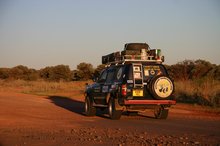
|
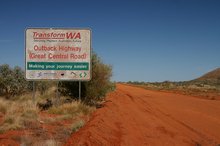
|
The dirt roads are maintained well here, better than most we've driven over on our travels, as it lowers the impact on the tyres of the trucks. At $45,000 per tyre (and there are 6 on each truck) it made a lot of sense to me, saving in the region of 3-4 million dollars a year. As we took a closer look at the tyres, the guide must have been reading my mind, as the next snippet of information made me glad Tinfish had such small wheels; with the amount of times we have now changed wheels on the car, we could probably do it blindfolded......the dumper trucks have 76 wheel nuts holding them on, it would take us a whole day to change one! It was a really interesting tour and the hour flashed by.
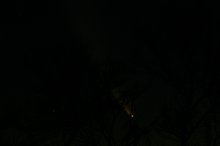
After a bite to eat, we carried on to the Hall of fame to finish our self-tour from the previous afternoon. With time still on our hands, we decided our next tour would be to the flicks. We went to see what was on and chose Night at the Museum starring Ben Stiller. I still find it strange when it's light outside after a movie, but by the time we'd finished our day's activities it was still only 6pm. We returned to camp for another relaxing night under the stars.
To our amazement, the wheels actually turned up the next morning, so after finishing all our other chores, we set off on our long journey inland. We stopped off at Gwalia, once a thriving goldmining town where in the late 1890's the mine was managed by Herbert Hoover, who later became President of the USA. Lots of the houses have been restored and we wandered round ghost town imagining what life used to be like for these miners. As the sun began to set, we continued our journey, soon arriving on the dirt road of the Great Central Highway, 1000km of dust that would take us to the Red Centre.
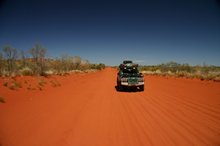
We found camp in a little clearing off the road, not really the best camp, but it would do. Soon the dark loomed and the stars began to twinkle in the sky. As we ate our dinner I gazed up into the sky and saw a comet, the tail drifting skywards as it dived to the earth, it was visible for about 30 minutes. We'd heard about it, but with town lights around us for the last week or so, we never had a clear sky. The sky was beautiful.
The next two days were long as we bounced and bumped over the Great Central Highway. The bush wasn't as I'd remembered it, trees, shrubs and grasses adorned the otherwise wilderness outback. It was much greener than I expected after boughts of well needed rainfall. 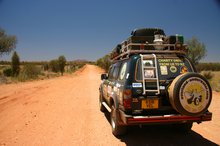 As we passed through the never-ending remoteness, it instilled yet more admiration in me for the Aboriginals who for years have trudged over the land, north to south, east to west in search of food and for trading. We found it hard enough in an air-conditioned car, I have no idea how they managed even a few miles on foot.
As we passed through the never-ending remoteness, it instilled yet more admiration in me for the Aboriginals who for years have trudged over the land, north to south, east to west in search of food and for trading. We found it hard enough in an air-conditioned car, I have no idea how they managed even a few miles on foot.
We stopped at Warburton where we'd heard there was an art gallery - maybe we'd be able to find a piece here for less than a few thousand dollars - but it was being refurbed so there was no stock was on display. As we crossed over the border from Western Australia to Northern Territory the roads became worse. Corrugations shook every bone in our body and I'm sure every bolt in Tinfish's. After two more hours endurance, we were rewarded..... we had our first glimpse of Kata Tjuta. In the distance you could have mistake them for small mounds, but it lifted our spirits and the rest of the journey didn't seem as punishing. We had made it to the Red Centre.
A HUGE thanks to Gary for letting us use some of his pictures......
| All content copyright � overland-underwater.com - please do not use without permission. |
| Comment from Marion |
| G'Day Charlene :-) Does that mean that Alex becomes Scott? Marion x |
| 26 Feb 2007 @ 20:58:53 |
| Comment from Chris |
| The guy in the gold room probably said "ning nong" which is a relatively benign term meaning a silly person. It's not used much any more. It is also not racist, demeaning or offensive in any way. Other than that I love reading about your adventures. |
| 03 May 2007 @ 03:39:57 |
